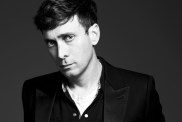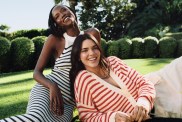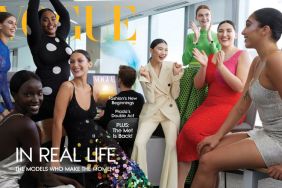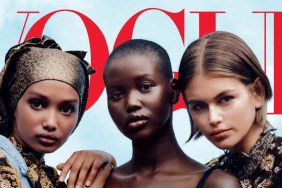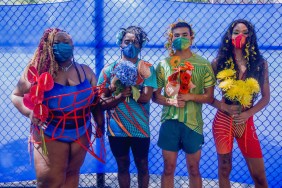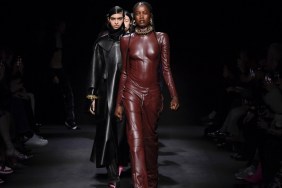Source: Olimpia Valli Fassi/YouTube
Glamour’s September issue H&M ad, which featured plus-size model Katy Syme and Ghanaian-English beauty Adwoa Aboah posing side by side with Heather Kemesky and Iselin Steiro, was a rarity among fashion campaigns. Plus-size models have only recently begun to snatch up traditionally straight-size jobs (think of Paloma Elsesser for Nike Women) and even then they’re often relegated to Instagram campaigns, cast as a fairly obvious marketing ploy and touted as “real” women as opposed to models. Runways and print ads may be more inclusive than ever before, but as Forbes’ list of 2016’s highest earning models clearly demonstrates, for many the opportunity just isn’t there. Models of varying shapes, weights, races and ages continue to be sold separately. That’s where the All Woman Project comes in.

Co-founders Clémentine Desseaux (left) and Charli Howard; Image: Courtesy of Heather Hazzan and Lily Cummings/All Woman Project
Led by Charli Howard and Clémentine Desseaux, two model-bloggers who’ve made international headlines thanks to their work as body positive activists and advocates of diversity in fashion, the multiplatform campaign celebrates the beauty of uniqueness and challenges the industry’s tendency to segregate models in ads. After meeting on a friend date orchestrated by their MUSE Management manager Becca Thorpe — who clearly has an eye for kindred spirits — the twosome went about enlisting a group of like-minded females (models, photographers, stylists and videographers alike) to bring their vision to life.
Joining Clémentine and Charli before the camera is a seriously inspiring group of models of all sizes, shapes and ethnicities, all of whom are committed to using their serious clout — we’re talking a combined Instagram following of upward of 3.5 million — to further the cause of diversity.

From left: Denise Bidot, Shivani Persad, Clémentine Desseaux, Leaf, Charli Howard, Victoria Brito; Image: Courtesy of Heather Hazzan and Lily Cummings/All Woman Project
The editorial stars androgynous model and activist Elliott Sailors, Trinidadian model and politico Shivani Persad, rapper and model Vickatrillion, former Miss Teen USA Kamie Crawford, musician Leaf, known for her feminist-leaning lyrics, and famed plus-size models and outspoken body positivity advocates Barbie Ferreira, Iskra Lawrence and Denise Bidot (as well as Denise’s daughter, cue the awws). “We got pretty much all the coolest girls,” a deservedly proud Clémentine told theFashionSpot.

Shivani Persad (left) with Barbie Ferreira; Image: Courtesy of Heather Hazzan and Lily Cummings/All Woman Project
The result? A series of gorgeous, unretouched, Calvin Klein-worthy shots that exemplify a new kind of fashion ad, one in which “women, in all forms, can stand alongside one another and sell a product.” There’s also a fun, fashion-filled, empowering-as-hell video to accompany the snaps (watch the full clip above).
To bring the campaign to the next level and truly get the public in on the discussion, the duo has partnered with social media startup clapit. On September 12, Clémentine, Charli, Barbie and the rest will take over the platform, asking women everywhere to download the app and share their own GIF showing what makes them a woman (using #IAmAllWoman, of course). We know what you’re thinking. This isn’t a gimmick, it’s an opportunity to support this grassroots feminist project — because the more widespread the conversation, the merrier we all shall be. As an added bonus, the most “clapped” about content will feature on AllWomanProject.com.
And speaking of getting in on the conversation, we caught up with Charli and Clémentine to talk about their experience in the modeling industry and starting a diversity revolution on no budget. Read the full interview below and after that, we promise we’re done fanning out.
theFashionSpot: Tell us about how you came to be where you are.
Charli: I was with a British agency for about three years and I did alright, but I wasn’t really making tons and tons of money from it. My real struggle was that no matter how thin I got, it never seemed to be good enough. I would constantly lose weight and I was very, very small. I looked really ill — I had gray skin and broke out all the time because I had no nutrients, I exercised constantly, I was in bed by 9:00 p.m. every night because I had no energy. Then last October my agency called me up and said, “We really appreciate how much you go to the gym, but you’re never going to be thin enough to be a model.” At that point I lost my shit. I went on Facebook and wrote a post and that wound up changing my life for the better. I made the move to New York (which was something they told me I could never do) and now I’m eating properly, being healthy and getting more work as a result.
Clémentine: I never really thought that this would be a career for me because back in France there’s no plus-size modeling at all. Then, in 2011, I booked a big commercial for a brand called Castaluna, the first to advertise plus fashion on French TV. I didn’t really plan on it being a huge thing, but people were kind of shocked in a good way — and a bad way — by the sight of a curvier woman and it shook things up a bit. Judging by the amount of commentary that provoked, I realized that this was an interesting conversation, that people — whether they love it or hate it — really do care about diversity. Then I moved to Miami and obviously modeling there was much easier given that the plus-size industry was pretty developed in the States. Through my work with American Apparel, I got signed to an agency here. Becoming a plus-size model helped me become more confident and better with my body. I always struggled with my shape and being too big and different and freckly — so many different things that were not accepted back in France. Moving here was kind of a liberation. It made me realize I wasn’t the problem — it was the people around me that took issue with diverse beauty. Since then I’ve been really outspoken regarding diversity because I’ve seen the effect it has on people. Women feel so liberated, happy and free after seeing plus-size models putting themselves out there, showcasing a different ideal of beauty.

Image: Courtesy of Heather Hazzan and Lily Cummings/All Woman Project
tFS: How did you two come up with the idea for the All Woman Project?
Clémentine: Over lunch we started talking about Charli’s story and diversity. We had also just seen this new brand that’s coming out called Phylyda — it’s a swimsuit brand that’s going to launch for resort this year. It’s the first brand that we’d heard of that caters to all different types of shapes — petite, plus, tall, skinny, curvy — which we both found so amazing. We were so blown away and it gave us an idea: “What if we focus on the concept of diversity by showcasing different types of beauty, different body shapes, different colors, in these suits?” We wanted to create the campaign we never get to be featured in — one that’s truly diverse, not done for the sake of marketing; made for women, by women. Then it was a matter of “how the hell do we do this?” We started pulling strings, enlisting friends, making it happen and so many people were so excited and so into it that it wound up being quite easy.
Charli: One of the things that Clem and I were really kind of confused by was why so many brands don’t really feature plus-size models and straight-size models together. We really wanted to show that all sizes can model together and look great doing it. Brands can be more diverse. And the fact that we’ve done it on little to no budget says a lot. If we can do that, bigger brands can definitely do it as well.
tFS: How did you go about finding participants?
Clémentine: All the brands we chose are women-led. Glossier for beauty, Phylyda, Outdoor Voices, Nasty Gal and more for styling. We were looking for brands not only led by women, but also ones that are pushing some kind of diversity or body positive message. That was quite the challenge, actually. But with the help of our stylist Calvy Click, we made it work.

Elliott Sailors messes with Leaf’s braid; Image: Courtesy of Heather Hazzan and Lily Cummings/All Woman Project
Everyone working on the project is a creative, from the videographers to the photographers to the models. They’re all women and really involved in the diversity issue. Our videographer Olimpia Valli Fassi has been working on a lot of women’s projects, for example the Nike Women videos. Her girlfriend Elliott is one of the models and is extremely active in the lesbian and gay rights arena. She wanted to make a point about the fluidity of genders, how we don’t need to be put in a box, female or male. She was also the first woman in the industry to do male modeling. In terms of photographers, we teamed up with Lily Cummings and Heather Hazzan — they’re actually starting their own magazine at the end of September that will focus on women’s projects and photographers. They’re super feminist. They started out as plus-size models and they’ve watched the industry — particularly the curve industry — evolve. It’s interesting working with them because they have such an understanding of curve models and how to photograph them as well as, and alongside, straight-size models. Some photographers I’ve encountered have issues working with different curves and dimensions.

Kamie Crawford (left) and Iskra Lawrence; Image: Courtesy of Heather Hazzan and Lily Cummings/All Woman Project
tFS: Are there any women in particular you’d like to see get involved? What are your plans for the future of the All Woman Project?
Charli: We want to use as many diverse girls as possible. Obviously, as it was our first project and funds were limited, it was hard to get all the girls we wanted. Hopefully, more girls want to get involved next time. It would be amazing to have Robyn Lawley or Philomena Kwao on board. In the future, we definitely want to create more videos, take it across the world and make the project bigger and better every time. If we can help some girls feel really good about themselves, then we’re doing something right.
tFS: What do you think of the term “plus-size”?
Clémentine: It doesn’t matter to me at all. You can call me whatever you want. It started out as an industry term. At this point, it’s kind of old school. I’d like to just be a model, but if it’s relevant, you can call me plus-size. I don’t love it, but I don’t mind it.
Charli: I think models should just be models. I don’t understand why we have to put them into categories. The plus-size thing is still very much an issue, but it doesn’t need to be anymore. Why can’t we move past that? Pretty girls will always sell products and that doesn’t mean that you have to put a size on that or divide them within an agency.
tFS: Can you comment on the campaign’s emphasis on realness and showing flaws?
Charli: We’re not trying to be like, “No company should ever use Photoshop!” What we want to show is that girls do have flaws and just because we’re models doesn’t mean we don’t have cellulite or stretch marks or tiger stripes on our thighs. If brands want to keep using Photoshop, that’s fine. You just don’t need to alter someone’s size. Once, when I was on a casting for a plus-size brand, I saw some of the girls padding out their clothes to look bigger. That’s something I just don’t understand. Brands should choose models based on who they are naturally rather than altering them to better adhere to either side of the spectrum.

Leaf and Clem flaunting x slaying; Image: Courtesy of Heather Hazzan and Lily Cummings/All Woman Project
tFS: What was your favorite part of the process?
Charli: Aside from working with Clem, I found it very therapeutic to be on set with all of these diverse women who embrace their so-called flaws. I still sometimes have those moments when I wonder, “Oh my god, am I the only person with cellulite and stretch marks?” And this helped quiet that voice.
Clémentine: It was amazing just being on set with all the girls those two days[!]. It was really cool to just turn around at any moment and see so many different colors and sizes and energies all working together toward the exact same goal. And knowing we were all creating something for other women to see and get confidence out of was incredible. It was really magical to realize that everyone showed up simply for the sake of being a part of it (since we had no money to offer). They just wanted to do right by other women. I think that was the most amazing part of it.
tFS: What does femininity mean to you?
Clémentine: I think we as women have a really intense drive, a force that pushes us to do amazing things and I think being a woman is being confident and being able to do those things. We talk about this in the video. The definitions of womanhood and femininity are so diverse. We had all 10 models come up with words that summate womanhood and femininity to them and the results were all so different. Resilient, loving and confident came up a lot.

Image: Courtesy of Heather Hazzan and Lily Cummings/All Woman Project
This interview has been edited and condensed for clarity.


